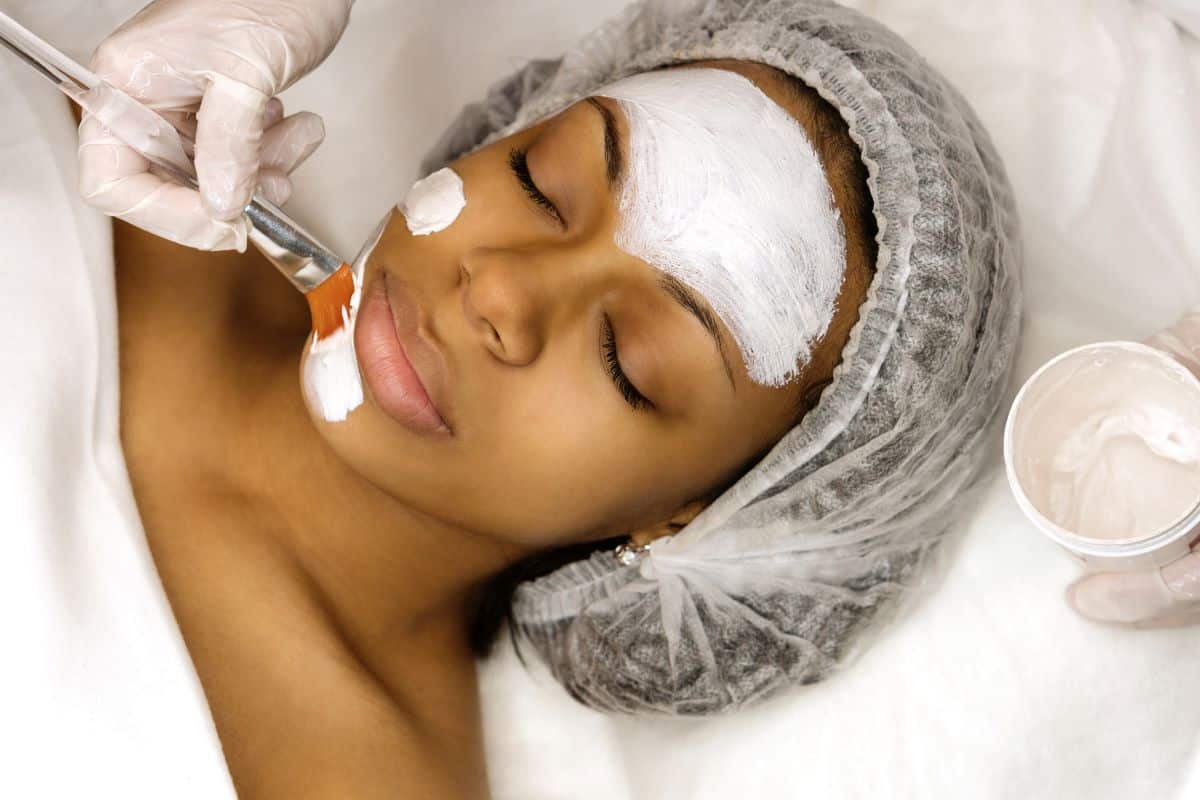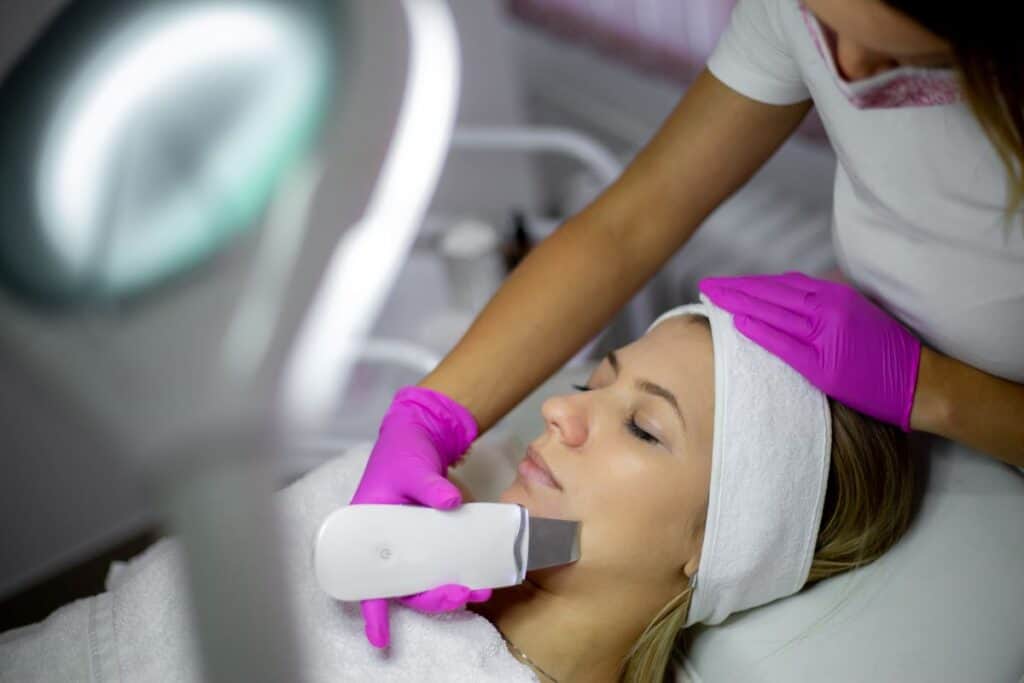
Introduction to Chemical Peels
Chemical peels have revolutionised the approach to skincare, offering a path to rejuvenation that many had thought unreachable. By applying a tailored chemical solution to the skin, this treatment targets many concerns, including sun damage, acne scars, and uneven skin tone. The allure lies in its ability to peel away layers, revealing fresher, more radiant skin beneath. Peels vary from superficial to deep, each designed to address specific skin conditions precisely. The appeal is undeniable for individuals battling dark spots or seeking to enhance collagen production. These treatments promise to illuminate the complexion and instil newfound confidence in one’s appearance. Among the various options for cosmetic enhancement, chemical peels stand out for their direct approach to improving skin texture and tone, making them a big deal in pursuing radiant skin.
Understanding Different Types of Chemical Peels
Chemical peels have evolved into a cornerstone of skin rejuvenation, inviting us to explore their varied landscape. At the mild end, superficial peels, often formulated with glycolic acid, tenderly exfoliate the skin, promising minimal downtime. These peels, ideal for those navigating the delicate balance of routine activities and skin care, target dark spots and uneven skin tone, offering a refreshed visage. Progressing to medium depths, trichloroacetic acid (TCA) peels delve deeper, orchestrating a more pronounced renewal for tackling age spots and fine lines. Their potency demands a short retreat from the daily hustle, ensuring the healing process unfolds undisturbed.
Deep peels are the most powerful type, great for treating serious acne scars and sun damage because they contain high levels of trichloroacetic acid. You’ll need a skin check from a certified dermatologist to ensure you pick the right peel. The right choice can boost collagen, which helps make skin look young and bright. But be prepared to wait, as healing takes weeks, though the promise of a long-lasting glow is worth it.
Pros of Chemical Peels
Chemical peels have carved a niche in the cosmos of skin rejuvenation. They boast many benefits, from enhancing skin texture to mitigating dark spots. I discovered that opting for the correct type of peel, be it glycolic acid or trichloroacetic acid, targets specifics like acne scars, sun damage, and uneven skin tone proficiently. This careful selection fosters improvements that are not just superficial. Chemical peeling fastens collagen production, a key element for maintaining a young appearance and vibrant skin. It effectively addresses age spots, making one’s quest for flawless skin less daunting. For people with darker skin tones or sensitive skin, consulting a board-certified dermatologist ensures the peel’s compatibility with their skin type, thereby maximizing benefits while curtailing risks. In my journey, the recovery process honed my patience, but witnessing my skin’s transformation affirmed that chemical peels are a valuable investment in pursuing a lasting glow.
Cons of Chemical Peels
Chemical peels, while widely celebrated for rejuvenating skin, bear their share of cons. Sensitivity to sun exposure tops the list. After undergoing a peel, your skin becomes more susceptible to the sun’s harsh rays, necessitating stringent SPF protection. Meanwhile, the possibility of adverse reactions cannot be ignored. Each skin type reacts differently to the chemical solution used. Glycolic acid, trichloroacetic acid, and other components might provoke redness, peeling, or even scarring in sensitive skin. It underscores the crucial step of consulting a board-certified dermatologist. They tailor the peel type – superficial or deep – to align with specific skin conditions, including acne scars, uneven skin tone, or age spots. Thus ensuring the procedure’s worth, minimizing risks, and maximizing the glowing benefits.
The Importance of Skin Type Consideration
Choosing the right chemical peel for your skin type is crucial. Glycolic acid peels may suit oily skins by helping unclog pores, whereas trichloroacetic acid peels could benefit drier types, aiming to diminish age spots and sun damage. I’ve seen sensitive skins react positively to milder, superficial peels, avoiding the harsher effects of deeper options. Darker skin tones require careful selection to prevent hyperpigmentation or scarring, a point I emphasize to anyone considering this treatment. I have observed that a tailored approach not only maximizes the radiant outcomes but also significantly curtails the risks of adverse reactions. This strategy has allowed me and others to circumnavigate potential pitfalls effectively.
Recovery Time and Aftercare
The journey to smoother, rejuvenated skin doesn’t involve applying a chemical peel. Instead, understanding the recovery times associated with different peel depths is crucial. Light peels often promise a swift bounce back, enabling individuals to resume daily activities almost immediately. These superficial treatments, leveraging milder chemicals like glycolic acid, focus on exfoliating the topmost layer, thus requiring minimal downtime. Medium peels, such as those using trichloroacetic acid, demand more patience. Healing could extend over a few weeks, with redness persisting even longer.
The road to recovery is lengthier for deep peels targeting more profound skin issues like severe acne scars or age spots. It could take weeks before the healing process concludes. Such peels penetrate the skin deeply, encouraging significant collagen production but also necessitating a rigorous aftercare regimen to prevent complications. Adhering to post-peel instructions from a board-certified dermatologist is non-negotiable. This commitment ensures that you not only maximize the benefits of your chemical peel, whether aiming to mitigate sun damage or uneven skin tone but also sidestep potential pitfalls, safeguarding your investment towards achieving a lasting glow.

Chemical Peels vs. Alternative Treatments
One must consider individual skin conditions and goals to assess the efficacy of chemical peels against alternative treatments such as laser therapy and microdermabrasion. Chemical peels, leveraging chemical solutions like glycolic acid and trichloroacetic acid, offer a potent route to address issues including acne scars, sun damage, dark spots, and uneven skin tone. This method enhances collagen production, which is crucial for skin’s elasticity and youthfulness.
However, chemical peels might pose a higher risk of pigmentation issues or irritation for those with darker skin tones or highly sensitive skin. In such cases, laser therapy or microdermabrasion could be safer alternatives. While less aggressive, these methods can still effectively target age spots and improve overall texture without the intensive healing process required by deep peels. Treatment choice often boils down to balancing desired outcomes with potential side effects, underscoring the necessity of consultation with a board-certified dermatologist.
Personal Stories: Real Results and Experiences
I saw a dermatologist who suggested a TCA peel for my acne scars and uneven skin. Starting this was scary because I’d heard tough recovery stories, but the chance for better skin was too tempting. It took a while for my skin to heal and the redness to go away, but eventually, my skin looked much clearer—a big win for me.
On the other hand, my friend tried glycolic acid peels to eliminate dark spots but ended up with irritated skin due to her sensitivity. Luckily, a strict aftercare routine calmed her skin down. This really showed us how important it is to understand your skin type and talk to a doctor before trying chemical peels.
Both our stories highlight how different the results of chemical peels can be. It’s a reminder that while peels can lead to great skin, you must think carefully before going for it.
Choosing the Right Professional
Ensuring the safety and effectiveness of chemical peels hinges on the expertise of the professional conducting the procedure. A board-certified dermatologist or a trained expert should always be your first choice. These professionals possess comprehensive knowledge about different skin types and the best chemical solutions for each. They also understand the intricacies of the healing process, especially for sensitive skin or darker skin tones, which may respond differently.
Here are tips to help you select the right provider: Look for certifications and memberships in reputable dermatological societies, which often indicate high proficiency and ethical standards. Inquire about their experience with TCA peels, glycolic acid, and other treatments relevant to your skin concerns. Don’t hesitate to ask for before-and-after photos of previous patients to gauge potential results. Lastly, a good provider will willingly discuss potential risks and tailor the peel to your specific needs, confirming their commitment to your skin’s health.
Cost Consideration: Is It Worth the Investment?
Looking into the cost of chemical peels, they can seem like a big investment. The price varies greatly, depending on whether you go for a lighter peel or a deeper one and the dermatologist’s expertise. Light peels are cheaper because they’re less intense and have a quicker recovery time. But deep peels, which target serious issues like deep acne scars or sun damage, are more expensive, not just in money but also in the time it takes to heal and the care you need afterwards. So, is it worth the money?
It really depends on what you’re trying to fix, like uneven skin tone, dark spots, or deeper issues like wrinkles. It could be a good investment if a peel can increase collagen and improve your skin where other treatments haven’t. Also, don’t forget about the ongoing costs. You might need more sessions to keep your skin looking great for lasting results from peels like TCA or glycolic acid.
Prepping Your Skin for a Chemical Peel
Before embarking on the transformative journey of a chemical peel, I understood the importance of meticulous preparation. Initially, I consulted with a board-certified dermatologist to identify the peel’s suitability for my skin type and condition. They emphasised halting the use of certain skincare products.
I had to avoid products containing retinol and those with exfoliating properties like glycolic acid a week before the scheduled treatment. This precaution aimed to prevent any undue irritation or sensitivity. Additionally, exposure to direct sunlight became a significant concern. I diligently applied broad-spectrum sunscreen daily, aware that sun damage could severely compromise the peel’s effectiveness and my skin’s healing process.
In the days leading up to the peel, hydrating my skin became paramount. My routine included gentle cleansers and rich moisturisers to ensure optimal hydration levels. This simple yet effective preparatory step promised to enhance the chemical peeling’s benefits, reducing potential discomfort and promoting a smoother recovery. With these measures in place, I felt confident and ready to embrace the promise of rejuvenated, glowing skin.
When to See Results: Timing and Patience
Many who undergo chemical peels expect immediate transformations. The reality, I learned, often deviates from these hopes. Initial outcomes may hide behind the healing process, which varies significantly with the peel’s intensity. Superficial peels might unveil fresher skin within a week, yet the deeper variants require patience. For me, TCA peels and those targeting deeper layers demanded a timeline extending several weeks for the full benefits to surface.
My journey with glycolic acid peels taught me the value of patience. Collagen production, crucial for that youthful glow, kicks in gradually. It’s not an overnight affair but a slow, rewarding reveal. I noticed discernable differences in acne scars and uneven skin tones, but only after allowing time for my skin to adapt and regenerate.
Expecting instant results from chemical peeling can lead to disappointment. Whether it’s reducing dark spots or mitigating sun damage, the key lies in giving your skin the time to renew naturally. Age spots and fine lines fade, not at the snap of your fingers but over consecutive treatments and weeks of care. Understanding this timing and embracing patience has led me to appreciate the true value of my chemical peel investments.
Making the Glow Last: Long-term Skincare Post-Peel
Maintaining the radiant results of a chemical peel demands a commitment to a meticulous skincare regimen. It isn’t simply about basking in the immediate glow but preserving it. Initially, after a peel, you’ll find your skin is more sensitive. It is paramount to shield it from sun damage. Ensuring diligent application of a broad-spectrum sunscreen with a high SPF becomes non-negotiable. Expect to integrate this practice into your daily routine, even on cloudy days.
Furthermore, the journey to sustained glow transcends what we apply topically. Hydration plays a crucial role. Drinking a lot of water has proven to boost skin elasticity and moisture levels, both vital for maintaining the outcomes of your peel. Another cornerstone in post-peel care is the use of gentle, non-abrasive cleansers and moisturizers. These products will help in avoiding irritation and support the healing process.
Lasting results also depend on you staying in touch with your board-certified dermatologist for follow-up treatments. The frequency of these sessions will vary based on your skin type and the intensity of the initial treatment. Together with professional guidance, adopting a balanced lifestyle, adequate sleep, and a nutrient-rich diet will further enhance and extend the benefits of your chemical peel.
The Verdict: Weighing the Glow Against the Grit
After exploring the world of chemical peels, from light to deep ones and their benefits, like more collagen and fewer dark spots, we’re at a point where we need to decide if they’re worth it. Peels, whether they use glycolic acid or trichloroacetic acid, promise a big improvement in skin quality, including smoother texture and fewer acne scars or sun damage.
However, it’s not all easy. Recovery from deeper peels takes patience due to the intensity of the treatment. There are also risks like sun sensitivity and possible bad reactions. These downsides highlight why it’s crucial to consult with a certified dermatologist, as the success and safety of the peel depend largely on their expertise.
Considering all these points, I believe that chemical peels can be a hopeful option for those dealing with specific skin issues and who haven’t seen results from other treatments. If you’re looking for a big change and can handle the recovery time, peels might be a good choice. Ultimately, if you’re prepared for the potential challenges and follow a professional’s advice, the benefits of chemical peels can outweigh the costs for many people looking to improve their skin.
So, what’s your take? Are you ready to dive into the world of chemical peels, or does the thought of navigating potential risks and recovery time have you hitting pause? Share your thoughts and experiences in the comments below—I’d love to hear whether you’re team peel or team ponder!






